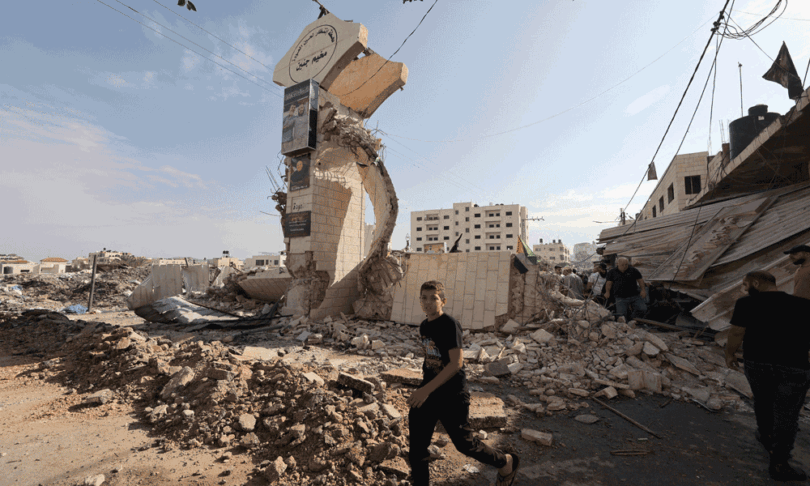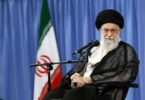GAZA/JERUSALEM (Reuters): Israeli troops and tanks attacked Gaza’s main northern city from both sides on Monday, three days after they began a major ground offensive in the Palestinian enclave that has stirred more international appeals for civilians to be protected.
Israel’s military said it had struck more than 600 militant targets over the past few days as it expanded ground operations in the Gaza Strip, where Palestinian civilians are in dire need of fuel, food and clean water as the war enters its fourth week.
Islamist militants said they had repelled an attempted thrust from Israeli tanks into Gaza City from the east and were fighting them on the border with Israel.
“Our duty today is fight and fight,” the Islamic Jihad militant group, fighting alongside Gaza’s ruling Hamas, said in a statement, adding that now was not the time for a ceasefire.
The Israeli military said it had killed four prominent Hamas operatives. “IDF troops killed dozens of terrorists who barricaded themselves in buildings and tunnels, and attempted to attack the troops,” it said in an update.
Neither side commented on the other’s reports.
Israel renewed warnings for civilians to move from the north of the tiny, densely populated enclave to the south as it began an advance into Gaza late on Friday to pursue Hamas militants it says are hiding in a labyrinth of tunnels under Gaza City.
Many Palestinians have stayed put for fear of becoming homeless like previous generations, and over alarm about Israeli aerial strikes further south.
Fadi, who lives in the Jabalia refugee camp on Gaza City’s northern outskirts and declined to give his last name, said the area was now in mortal danger from Israel’s ground offensive with tanks rumbling on its fringes. But he vowed not to flee.
“The entire place here is full of people. No one in the entire neighbourhood has left. We are staying,” he told Reuters by phone. “Whether tanks or planes, there will not be another displacement (of Palestinians). That is our decision even if that will mean our martyrdom (death).”
On Monday, residents said Israeli forces carried out dozens of air strikes on Gaza City’s eastern side, with some reporting the roar of tanks rolling in amid exchanges of fire. A social media post appeared to show one tank on the main Salahudeen Road that connects the city to the enclave’s south.
Later, residents and the Hamas-run government’s media office said the tanks had pulled back towards the fortified boundary fence around Gaza. Hamas’ armed wing said intense mortar fire had pushed them back and fellow militants Islamic Jihad said its fighters were battling Israeli forces there.
To the west, the narrow enclave’s coast road was hit again several times from the air and sea and from Israeli forces on the ground to the north, residents said.
Reuters could not immediately verify the reports.
Palestinian health officials reported air strike impacts near three large hospitals in Gaza City on Monday. The U.N. humanitarian office OCHA said 117,000 civilians were sheltering alongside patients and doctors in hospitals in the north.
Israel has accused Hamas of placing command centres and weaponry near hospitals, which the group denies.
“Where should we go? It is all one death,” said Hatem Sultan, sheltering near Gaza City’s al-Shifa Hospital, the enclave’s biggest medical centre, where ambulances were constantly arriving with the injured.
In the south, blasts from air strikes shook the town of Rafah near Gaza’s only operational border crossing, with Egypt, and east of Khan Younis, where Palestinian media said Hamas clashed with Israeli troops.
Clashes in West Bank
Israel has said 1,400 people were killed and 229 taken hostage when Hamas-led militants burst over the border and rampaged through nearby Israeli towns and kibbutzes on Oct. 7, the deadliest single attack in Israel’s 75-year history.
An Israeli soldier who was among the hostages was freed in Gaza during the operation, the military said on Monday. It said the soldier had since undergone medical checks and was “doing well.” It did not give details on the circumstances of her release.
Hamas has released four hostages so far and said 50 have been killed in retaliatory Israeli strikes.
Medical authorities in Gaza, where 2.3 million people are crammed into an enclave 45 km (28 miles) long, said on Monday that 8,306 people – including 3,457 minors – had been killed.
OCHA said rescuers were struggling to reach stricken people. “As of 29 October about 1,800 people, including at least 940 children, have been reported missing and may be trapped or dead under the rubble, awaiting rescue or recovery,” it said.
The U.N. agency also said armed groups continued firing rockets at Israel indiscriminately, with no fatalities reported.
The Israeli defence ministry issued video footage of what it said were manoeuvres inside Gaza showing soldiers in buildings, tanks on a main road, and air strikes on what it said were buildings occupied by Hamas. Reuters could not independently verify details in the footage.
“We are moving from the ground, spotting the terrorists and attacking from the air. There is also direct engagement between ground forces and terrorists,” military spokesperson Rear Admiral Daniel Hagari said.
Hamas and Islamic Jihad said they were also fighting Israeli forces in the Israeli-occupied West Bank city of Jenin. The Palestinian health ministry said four people were killed there on Monday and Israel said an air strike killed several fighters.
Airport unrest in Russia
The conflict has led to large demonstrations worldwide in support of the Palestinians, and antisemitic and Islamophobic harassment and attacks are increasing.
Russian authorities said they had taken over an airport in the predominantly Muslim Dagestan region and arrested 60 people after hundreds of anti-Israel protesters stormed the facility in search of the Jewish passengers from a plane from Israel.
Israel’s widening ground attacks on Gaza have spurred international calls for a “humanitarian pause” to allow aid in unimpeded. Drastic shortages have triggered civil unrest, with people storming aid stores on Sunday in search of food.
Civil disorder has put four U.N. aid distribution centres and a storage facility out of action, UNRWA said on Monday.







